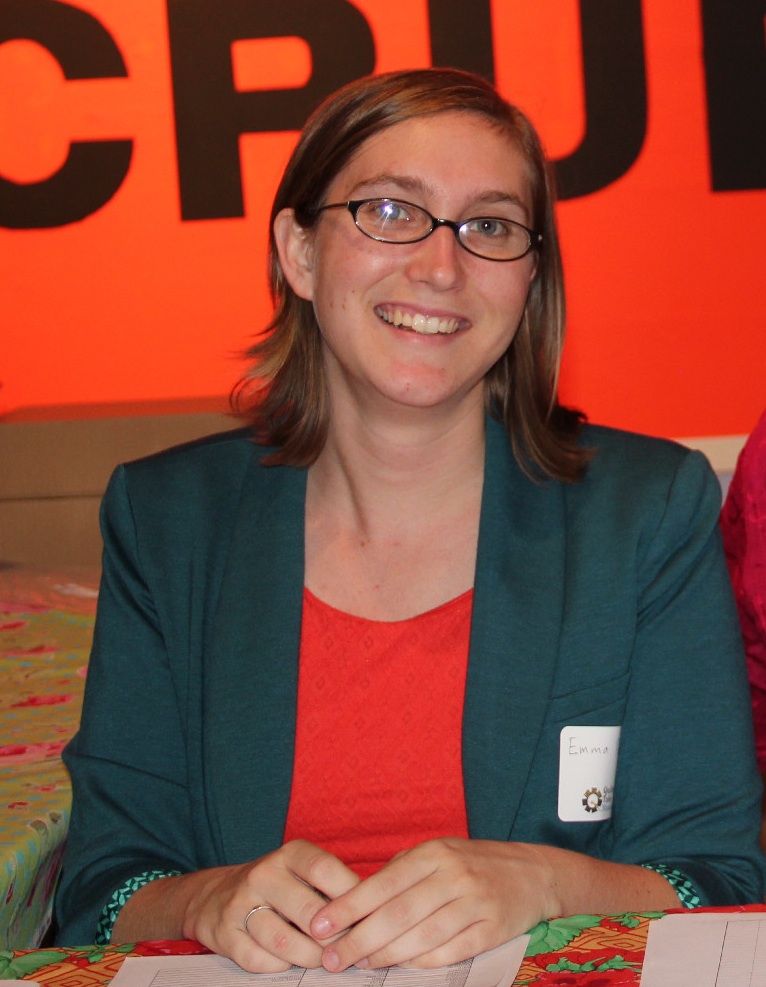Today’s Q.S.O.S. Spotlight features two quiltmakers, Sharon K. Naegle Eshlaman and Theresa Boock, answering the same question: In what ways do you think your quilts reflect your community or your region? Though these women live over 2,280 miles away from each other, they each feel their quilts say something about themselves, and where they live. Read on as they share more about their quilts and their communities.
First, Sharon K. Naegle Eshlaman, of Michigan:
 It’s a quilt I made some years ago, probably around the year 2000. I was always interested in stars. It came out of a magazine, which I’ve since discarded, can’t tell you what year, what designer, really anything about it. I love plaids and stars, so I chose that pattern.
It’s a quilt I made some years ago, probably around the year 2000. I was always interested in stars. It came out of a magazine, which I’ve since discarded, can’t tell you what year, what designer, really anything about it. I love plaids and stars, so I chose that pattern.
JR: What do you think someone viewing your quilt might conclude about you?
SE: It’s Americana. I love my country. I love simplicity and it speaks country to me, country life.
JR: In what ways do you think your quilts reflect your community or your region?
SE: Well, as far as the Americana that I really enjoy, the stars, with the wars in the world now and our people coming back from overseas, I think it relates to that. I like appliqué floral quilts, thinking of my garden, that I occasionally tear myself away from quilting to work on. I work with a lot of homespuns and basically I’m just a down-to-earth girl. I’ve got my chickens and my garden and I think my quilts kind of show that’s the type of person I am.
Next, Theresa Boock of Eugene, Oregon:
 I can tell you this quilt is a king size quilt. It’s 103″ square. It’s a very traditional style quilt, although I designed it. So it is a traditional style pattern with more modern fabrics. A combination of old and new. It’s got roses on it, and leaves, traditional rose wreath patterns and blue ribbons. Green leaves and burgundy roses, and pink.
I can tell you this quilt is a king size quilt. It’s 103″ square. It’s a very traditional style quilt, although I designed it. So it is a traditional style pattern with more modern fabrics. A combination of old and new. It’s got roses on it, and leaves, traditional rose wreath patterns and blue ribbons. Green leaves and burgundy roses, and pink.
LP: Who made it?
TB: Well it is a friendship quilt. I belong to an organization called the Pioneer Quilters, and we had a friendship block exchange. There were twenty-four of us involved and every month we distributed our patterns and whatever fabric we wanted people to use and they had a month to make our block and return it, and it took two years altogether from start to finish, the friendship exchange. And then, I pieced the blocks, and added a little bit more to the boarder, and then the group Pioneer Quilters quilted it. And it took eight months. We quilted on it about four hours a day, for eight months. I mean, once a week for eight months.
LP: In what ways do your quilts reflect your community or region?
TB: Pacific Northwest is sort of cutting edge for quilting. It’s really fascinating to have watched it evolve over the last thirty years. I sometimes feel like I’m a step behind because I’m not into the bright colors a lot of the quilters around here are in the Pacific Northwest… Being a fourth generation Oregonian, what you see in my quilts is a reflection of my region. And anything else I’ve brought into it by traveling, but truly, I’m about as dyed-in-the-wool Oregonian as you can get…
LP: In what ways would we see that in your quilts?
TB: A lot of the folks that came to Oregon in the 1800’s, some of them came from New England, and there is a lot of traditional New England beliefs hidden in design. Some of the folks came from Northern Europe, and you see a lot of, for instance, my father’s family is Dutch, German and Belgique and they were very fine craftsmen. And I see that eye for detail.
How do your quilts reflect your region? You can read more quilt stories–from all over!–on the Quilters’ S.O.S.- Save Our Stories page on the Quilt Alliance website.
Posted by Emma Parker
Project Manager, Quilters’ S.O.S.- Save Our Stories
qsos@quiltalliance.org

